The disadvantages of open artificial reservoirs become apparent already on the first day of operation. A dome for a pool, made by hand, will greatly simplify the maintenance of the structure, make your rest more pleasant.
Purpose of a light roof
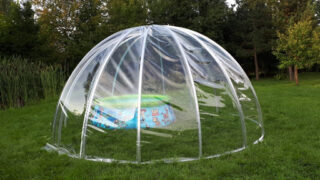
A pool cover solves many problems:
- The air warms up quickly, and the temperature remains comfortable for a long time - the pool can be used after sunset and in cloudy weather.
- Water warms up faster in a covered room due to less evaporation and warm air.
- Closed doors will prevent unauthorized bathing of children, which can lead to tragedy.
- The surface of the water is protected from debris, falling leaves, bird droppings, which reduces the time and financial costs for cleaning.
The degree of protection depends on the structure of the frame and the material of the dome.
Building options
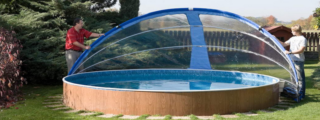
Depending on the mode of use of the structure, the pavilion for the pool is portable (mobile) or stationary. The mobile version is suitable for summer frame and inflatable pools, which are removed when it gets cold or installed annually in different places. For ponds dug in the ground, stationary options are used, rigidly attached to the base or mounted on a light foundation.
The design of a polycarbonate pool canopy can be:
- open from the sides, in the form of a canopy or canopy;
- sliding or lifting, to ensure access to water only at the right time;
- with sliding or swing doors.
The most widespread are domed roofs and canopies in the form of tents.
Which option to choose depends on the location on the site, the size of the pool and the design idea.
Applicable materials
Domes for pools are on sale in a disassembled state, but it is much cheaper to assemble a polycarbonate pool frame on your own and cover it with a suitable material.
In general, the structure of the dome consists of a frame, protective coating and fittings. A wide variety of component combinations can be used.
Frame
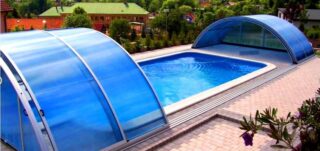
The easiest and most affordable material to work with is wood. The timber is sold in any hardware store, the price for it is minimal. For assembly, you will need very few tools: a hacksaw, a drill, screwdrivers and measuring tools.
The relative disadvantage is the slight durability, but this is only compared to metal and plastic. The frame will last about 10 years if it is pre-treated with antiseptics, the paintwork is restored in a timely manner.
Propylene pipes can withstand up to 30 years of operation if protected from sunlight. To do this, opaque materials or polycarbonate with UV protection are chosen as the roof.
On the Internet, many advise using composite reinforcement for the frame. It is forbidden to do this - from the influence of the sun, the material gradually collapses, the smallest glass needles fall into the air. Once on the skin or mucous membranes, these dust particles cause severe itching.

Galvanized steel and aluminum profiles can be purchased ready-made (curved) or straight parts can be used.The materials are durable and strong, slightly corroded. Among the disadvantages of such frames are the high price and the need to manufacture (purchase, rent) a bending machine if the right angles of the dome do not meet the architectural requirements.
Round steel pipes are durable and can be easily bent on their own. The material did not become popular due to the high cost and difficult attachment to the round details of the canopy.
For a home craftsman, the best solution is to make a frame from rectangular metal pipes. They are not too expensive, durable, easy to work with. To bend the metal, a simple pipe bender is enough, which is assembled from scrap materials in 2-3 hours.
Protective covering
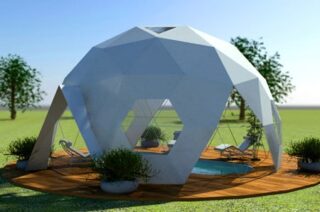
For open pavilions, opaque fabrics can be used, but they do not let the sun's rays through. The water heats up for a long time and cannot be higher than the air temperature. Therefore, they choose transparent types of materials.
Cellular polycarbonate has a minimum weight, is durable, and is painted in various colors. Depending on the dimensions, snow and wind loads, sheets with a thickness of 4 to 8 mm are chosen. Pavilions covered with cellular polycarbonate with a thickness of 16 to 20 mm can be used year-round if the reservoir is equipped with heating.
Plastic wrap is the cheapest option to tighten the frame over the pool. These are all its advantages. The material is short-lived, the appearance of the pool is unattractive. The gusty wind tears the film easily.
A PVC or LDPE awning will last for several years if removed and stored indoors in winter. Products of different thicknesses and colors are produced, there are products with reinforcing threads. Low weight allows PVC to be used in combination with lightweight polyethylene pipe frames.
Monolithic polycarbonate lasts up to 50 years in outdoor conditions, is available in different thicknesses and colors, is completely transparent and does not scatter the rays of the sun.
Glass is an option for year-round stationary pavilions. Pay attention to the material for the roof. The thickness of the blade must be sufficient to withstand the snow load. It is undesirable to use in regions where there is a large hail. For glass shelters, frames are provided that can withstand a large glass weight.
During construction, a combination of frame and coating is chosen based on the mass and strength of the materials.
Choice of sizes
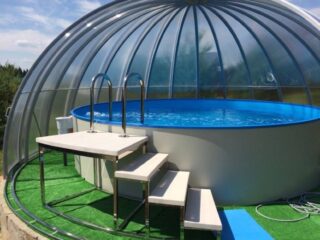
The dimensions of the roof must meet the assigned tasks. For example, the height of removable options can be about 1 m. Such structures are removed before swimming in the pool and returned to their place the rest of the time. Similar types are built to shelter a stationary pool for the winter.
The cover should not touch the sides of the pool when it is covered with a lid.
High roofs are made if it is assumed that the pavilion will be stationary. The head of the tallest visitor should not touch the frame elements. A height of about 2 m is considered optimal for the area where people move.
Heavy and stationary structures are installed along the outer perimeter of the bowl on the ground or foundation. Lightweight removable options can be placed on the side of the pool, making sure to provide fasteners so that the roof is not blown away by the wind.
DIY instructions
A pool in a country house with a polycarbonate roof is built according to a simple algorithm:
- Making a sketch, diagram and working drawing.
- Selection, purchase and delivery of material.
- Preparation of tools and consumables.
- Manufacturing of frame and doors (sashes).
- Sheathing of the frame and the entrance group with polycarbonate.
Depending on the design, the procedure may vary slightly. For example, door sashes are sometimes sheathed prior to installation.
The easiest option for self-repetition is to build a pool covered with polycarbonate at the dacha. The frame is welded from shaped steel pipes.
Design

Work on the drawing begins after installing the pool and taking accurate measurements. Measure the height of the bowl, diameter or linear dimensions.
Next, a sketch is drawn up, which reflects the appearance that meets the design requirements. It is taken into account that a standard sheet of cellular polycarbonate in total width is 210 cm.
If overlapping sheets are to be laid, the working width should be taken as 2 m.
There are always H-type joining parts for two sheets on sale, but with a honeycomb carbonate thickness of up to 10 mm, the joints diverge with temperature fluctuations, water begins to drip from the ceiling, and attractiveness is lost. For home constructions, it is better to stack the sheets on top of each other.
The frame consists of longitudinal and transverse logs, the maximum distance between which should not exceed 1 m. Focusing on this figure, the elements are applied to the sketch.
You can calculate the length of the bent vertical posts of the domed pavilion using school formulas for a circle. The length of the sheets of cellular polycarbonate is usually a multiple of 3 m, the maximum is 12 m. Based on this, the racks are calculated so that the cut sheet is used with a minimum amount of waste.
Frame fabrication
To build a frame from a shaped pipe, you will need:
- welding machine and protective mask;
- a drill for attaching the base to the foundation and the door hinges to the frame;
- angle grinder (grinder);
- pipe bender;
- tape measure, level, plumb line, marker.
Consumables are used to prepare electrodes, cutting and grinding wheels for grinders, drills or bits for drills, self-tapping screws, paint, paint brushes.
A reliable and durable frame is obtained from a 20x40 mm profile pipe with a wall thickness of 2 mm. Working with such material is simple, the price of parts is low.

Work progress for the tunnel dome:
- A rectangular base is welded and attached to the ground or foundation.
- The pipes are cut according to the dimensions calculated when drawing up the drawing.
- Using the simplest pipe bender, arches are made. Care should be taken to ensure that all elements are the same. The number of arches is calculated so that they are located at a distance of 1 m from each other.
- Arches are welded to the base, special attention is paid to the verticality of the installation. First, the parts are grabbed, the position is adjusted and the final welding is carried out.
- Horizontal crossbars are mounted. There are two options: weld the pipe over the arches, or cut and butt-weld lengths of 96 cm if the pipe width is 4 cm. The second option is preferable, since the sheet will rest on both the beams and the arches.
- The end arches are reinforced with cross members, which at the same time will serve as the door frame.
- The door frame is made. Door hinges are welded or screwed on. Install locking mechanisms or locks.
- Attach the doors to the frame.
After the end of welding, the joints are thoroughly cleaned from scale and metal sagging.
The frame is treated with an anti-corrosion primer for metal for outdoor use and painted with 2 coats of paint.
Fastening polycarbonate
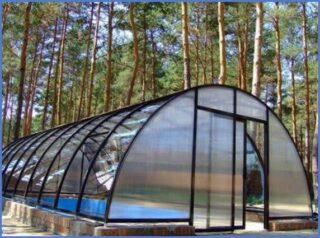
There are three options for attaching cellular polycarbonate to the frame.
- On the screws. Having attached the sheet to the frame, a hole is drilled in the carbonate and one wall of the profile pipe. Carving is made in metal. Fasten the screw, after placing a rubber or silicone gasket and a washer under the head. The method is laborious and time-consuming, but the screws, as a rule, do not loosen from vibration, they are easy to unscrew and remove the protection, for example, for the winter period.
- On bolts with nuts. Drill polycarbonate and both pipe walls. Use a bolt of the correct length with an elastic washer and washer. Fasten a nut from the inside.There are two drawbacks. You will have to work together, since the arms are not long enough to hold the wrench and screwdriver. There will be a nut on the inside, which is not aesthetically pleasing and can lead to scratches.
- For roofing screws. The easiest and fastest way. The finished dome has a drawback - the screws will have to be tightened periodically, since from fluctuations in temperature and vibrations, the fasteners gradually unscrew and fall out.
If desired, the joints of carbonate sheets are glued together with metallized tape, and a starting profile is put on the ends. For summer pools, these procedures do not make much sense.
Care during operation
It is recommended to periodically clean the dome and arched pavilions from dust and dirt. Use a hose. The deposits are washed off with a stream of water.
As needed:
- clean the guides of the sash if the structure is lifting or sliding;
- lubricate hinges and locking devices;
- check the reliability of the polycarbonate fastening, if necessary, eliminate the gaps;
- timely restore the paintwork.
The time spent building the pavilion quickly pays off due to the infrequent maintenance of the pool. Do-it-yourself construction of a structure allows you to create unique design structures, while saving significant financial resources.









Well done!!! Thanks for the video, I'll do it too